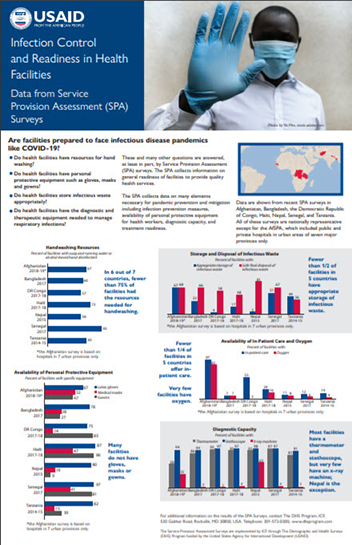Service Provision Assessments Shed Light on Health Facility Readiness to Control COVID-19

Are facilities prepared to face infectious disease pandemics like COVID-19? A new fact sheet explores infection control and readiness in health facilities from seven Service Provision Assessments (SPA) conducted in Afghanistan, Bangladesh, the Democratic Republic of Congo, Haiti, Nepal, Senegal, and Tanzania. The SPA collects information on the availability of different health services in a country and facilities’ readiness to provide those services.
- In six out of seven countries, fewer than 75% of facilities have soap and running water or alcohol-based disinfectant for handwashing. Senegal is the exception, where 95% of health facilities in Senegal have these resources for handwashing.
- Availability of personal protective equipment (PPE) such as latex gloves, medical masks, and gowns varies. In Nepal, latex gloves are available in 80% of facilities, while only 19% have medical masks and 9% have gowns. In the Democratic Republic of Congo, gowns (83%) and latex gloves (75%) are more common than medical masks (14%).
- In Haiti, only 17% of facilities have appropriate storage of infectious waste, and fewer than half of facilities have safe final disposal of infectious waste. In Tanzania, 44% of facilities have appropriate storage of infectious waste, while 36% have safe final disposal of infectious waste.
- Fewer than 1 in 4 facilities in five countries offer in-patient care. Few facilities have oxygen.
- Most facilities have a thermometer and stethoscope. In Bangladesh, 86% of facilities have a thermometer and 94% have a stethoscope.
Explore indicators on infection prevention, PPE, diagnostic capacity, and newly tabulated indicators on therapeutic readiness in the new fact sheet.
Access SPA survey final reports here.
Featured Image © YoPho, stock.adobe.com


